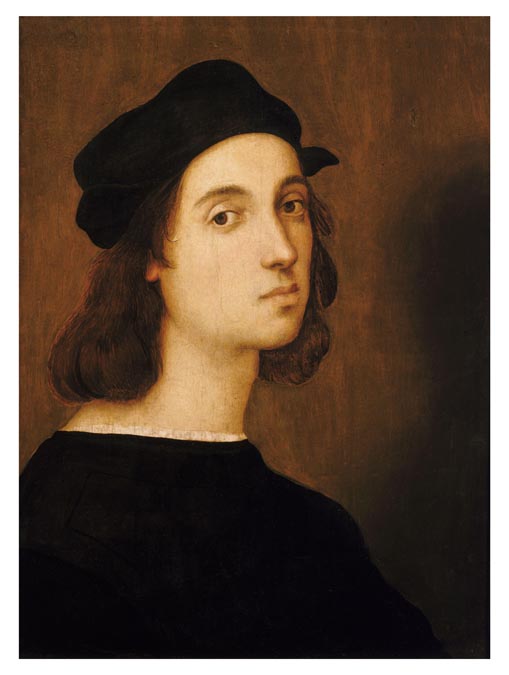
Raffaello Sanzio was born March 28, 1483 in Urbino, Duchy of Urbino. Both parents died when he was a young child, so he essentially grew up as an orphan.

Urbino was not the promising center of artistic paintings as was Florence or Rome. His father was court painter to the ruler of Urbino, but he died when Raphael was 11.
Raphael trained in the workshop of Perugino and was described as a fully-trained Master by the year 1500. He moved to Rome at the invitation of the pope to work on the Vatican Palace.
He was given a series of important commissions and began to work as an architect. Raphael was quite influential in his lifetime. His more serene and harmonious qualities were regarded as the highest models.
When he was studying in Florence, Raphael received commissions which now hang in the National Gallery, London, One fresco is in poor condition having almost completely lost the figure of God the Father above Christ. The theme that was in vogue would show a group of saints adoring the Trinity.
Pope Julius II was one of the great architectural patrons. He began to rebuild St. Peter’s in Rome. Raphael had designed the frame of the ceiling as Papal architect. He worked with four tondi and their rectangular panels. The “Ceiling of the Stanza della Segnatura” in the Vatican Palace is a masterpiece of design and color.
Nothing in the ceiling prepares the visitor for Raphael’s mastery of scale and decorum in these four great wall-frescoes. Raphael drew upon an incomparable range of classical sculpture for the frieze-like composition. Poses and drapery were adapted from large-scale statues
Raphael’s success in the service of the Papacy did not allow him much time to work for others. He was given the powers of Prefect over all antiquities unearthed within or a mile outside, Rome. He is considered one of the finest draftsmen in the history of Western art.
He, however, completed many important private commissions. In the period before his appointment as architect of St. Peter’s in 1514, he continued the series of devotional paintings with which he made his reputation in Florence. When looking at his paintings, it is obvious that this was the work of a master talent whose social skills propelled him to great success during his lifetime. He was engaged in 1514 to Maria Bibbiena and had many lovers.
In December 1516 he received the final payment for the tapestry cartoons. In March 1518 he received payment for the Logge May 24, 1519 the Logge was finished. December 26 1519 seven of the tapestries woven from Raphael’s cartoons were hung in the Sistine Chapel.
His death was recognized as a tragedy by contemporaries. In a letter written from Rome to Isabella d’Este the day after his death, the sorrow was described “for the loss of the hope of great things that were expected of him, which would have served as an honour to our age.” With his death Raphael was honored with the decision to have him buried in the newly-restored tabernacle in the Pantheon.
The Pantheon seems the natural resting place for such a distinguished artist.
His life was short, with death at age 37 on Good Friday, April 6, 1520. His work lives on through generations. He was an architect of the High Renaissance and his work is admired for its clarity of form, ease of composition, and visual achievement of the ideal of human grandeur. The Pope and four cardinals dressed in purple attended his funeral procession.

